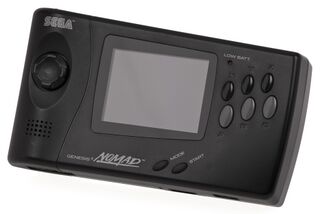Difference between revisions of "Sega Nomad"
From Sega Retro
(Use of "Mega Drive" causes several inaccurate and outright wrong statements, switched to Genesis for sake of truth and accuracy) |
|||
| Line 55: | Line 55: | ||
==Physical Scans== | ==Physical Scans== | ||
{{Scanbox | {{Scanbox | ||
| − | | console= | + | | console=Nomad |
| region=US | | region=US | ||
| front=Sega Nomad box front.jpg | | front=Sega Nomad box front.jpg | ||
Revision as of 16:32, 8 May 2015

| |||||
| Sega Nomad | |||||
|---|---|---|---|---|---|
| Manufacturer: Sega | |||||
|
The Sega Nomad, codenamed Venus, is a handheld video game console manufactured by Sega. It is a portable Sega Genesis, and Sega's second handheld system after the Sega Game Gear. The Nomad was based on the semi-portable Sega Mega Jet, and only saw release in North America.
Contents
History
The Sega Nomad was designed by Sega of America, likely another attempt to extend the shelf life of the already successful Sega Genesis (Sega Mega Drive in all other regions). At the time of release, home consumers were geared up for a new generation of video game consoles, namely the Sega Saturn and Sony PlayStation, but with an established game library of over 600 titles at this point and vastly improved hardware over the competition (mainly Nintendo's Game Boy), it was presumed that there was a place for the Nomad.
Sega were also backing their first handheld, the Sega Game Gear at this time, however sales were comparatively slow when compared to Nintendo. It is rumoured that at one stage, the Nomad was due to be a successor to the Game Gear sporting a touch-screen interface, a couple of years before the concept was pioneered with the Tiger Game.com. However, in 1995 it was rumoured that a system utilising this technology would cost roughly $289 to manufacture, and so the idea was scrapped for a handheld Genesis instead.
The Nomad debuted on North American store shelves in October 1995 for an asking price of US$180. Though the handheld received praise from critics, sales were sluggish, even after a US$100 price drop in the months which followed. It was discontinued shortly after. The Nomad never made it to other regions of the world, however it appears at one stage plans were made to bring it to Europe.
It is estimated that in total, roughly one million Nomad units were sold - ten million less than the Game Gear (but 600,000 more than the Game.com).
Hardware
The Nomad is built very similarly to the Game Gear and also shares several design flaws. It has a built in high-quality backlit 3" passive-matrix LCD screen, a D-pad and six face buttons and can be hooked up to a television (using the same cables as the Genesis II; the Nomad outputs both composite video and RGB). Also included is an extra DE-9 port for an extra player, though player 1 must always use the controls built into the Nomad unit. The Nomad accepts any Sega Genesis cartridge (though is still region locked), though its design means it is not compatible with add-ons such as the Power Base Converter, Sega Mega-CD or Sega 32X.
There are minor incompatibilities with some Genesis games, and though the LCD screen is of a higher resolution than other handhelds realeased around the mid-90s, the technology means that fast action scenes suffer from "ghosting" (i.e. blurry graphics). Like the Game Gear before it, the fluorescent backlight rapidly drains battery life, giving approximately three to five hours of play. Furthermore, the system is powered by six AA batteries, meaning it is expensive to maintain, however the Nomad PowerBack, which is charged via an AC adapter, can extend play time by a couple of hours.
Genesis games with small text are also difficult to read on a Sega Nomad. Similar problems occur when attempting to play Sega Master System games on the Game Gear via the Master Gear Converter.
Though never released in PAL regions, the Nomad can be modified to play PAL games in a similar manner as the Genesis/Mega Drive consoles.
Game Issues
The following Genesis titles are known to have difficulty with or not to work at all on the Nomad:
- Bonkers
- Chakan
- Decap Attack
- Forgotten Worlds
- Golden Axe II
- King of the Monsters
- Phantasy Star MD
- Pit-Fighter
- Outback Joey
- Shadowrun
- Sonic the Hedgehog
- Streets of Rage
- Trouble Shooter
Note that Sonic the Hedgehog and Streets of Rage's incompatibility issues can be worked around by running their 6-Pak counterparts.
X-Men is also not fully compatible with the Nomad - at one point in the game the player is forced to reset the console to continue, but the Nomad lacks a reset button.
Physical Scans

